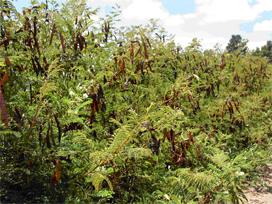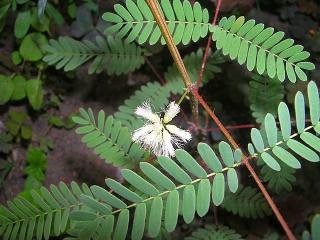Timbre
 Common Name:1 Timbre, prairie acacia, fernleaf acacia
Common Name:1 Timbre, prairie acacia, fernleaf acacia
Scientific Name: Acacia angustissima
Climate: warm, temperate
Plant Description: It is a large shrub or small tree up to 6 meters tall with a single short trunk and alternate compound leaves. Its branches are spineless and have several small narrow ridges that extend along the length of the branch. Its leaf stems are hairy and do not have any raised structure. The stems of older trees have a relatively smooth bark, which is brown or taupe in color. The leaves are twice compound and alternately arranged along the stems. Each leaf is carried on one stem and has nine to 25 pairs of branches. It has inflorescences in short clusters, with whitish heads (2.0 cm diameter) that turn orange when dried. The pods are dehiscent, oblong, 3–6 cm long and 6–9 mm wide, with curvy margins, initially green, turning brown-brown when they mature.
Cultivation: It grows in full sun and in intermediate shade.
It is found in deciduous or semi-deciduous tropical forests. Tolerates cold climates (occasionally freezing temperatures). It also resists moderate periods of drought, conserving its green foliage in the long dry season. It prefers acid free draining soils but adapts to a wide range of soils including vertisols with slightly alkaline pH.
It is propagated by seed sowing but seems to obtain better results when grown from transplanted seedlings than by direct sowing. Sow in places where there is not much competition for the soil with other plants. If you sown directly into the ground it is important to make sure not to sow too deep. Seeds should be sown on a cultivated soil surface and covered with a layer of soil equal to the width of the seed. The best results are obtained by soaking the seeds for 12 hours in cold water before sowing. The seeds have the ability to remain dormant for up to a year and are even to survive fires.
It needs regular watering or a season of normal rainfall.
This species regenerates quickly, therefore hard pruning or stump regrowth can be performed easily, the pruning residues can be used as mulch or to compost. Lower branches can be pruned to increase canopy height. If it is cultivated for wood yield, it should be planted and maintained in rotations of 20 years.
When the tree reaches five years of age and is 10 cm in diameters and 4 meters high it is used for firewood. When the tree reaches a height of 6 m is ready for tanning leather.
 Uses: It is a forage plant.
Uses: It is a forage plant.
Its flowers are used for beekeeping. Its fruit, seed, leaf and bark are used as anti dysenteric, anti-inflammatory and antitussive.
The fruits are used to induce the fermentation of pulque and tanning skins.
It is a nitrogen fixing plant.
Thanks to its deep roots, it is used to reduce erosion and to improve the soil. The firewood is of good quality and can be used as a support for vines.
It is a medicinal plant and is used to treat bile, mouth and teeth, as well as to cure diarrhea, gastritis; control fever; treat anemia and rheumatoid arthritis. It is used to cure respiratory tract infections.
Pests and Diseases: Generally not affected by pests or diseases. These that sometimes are present are: glasshouse red spider mite and mealybugs.
References:
En español: Timbre
